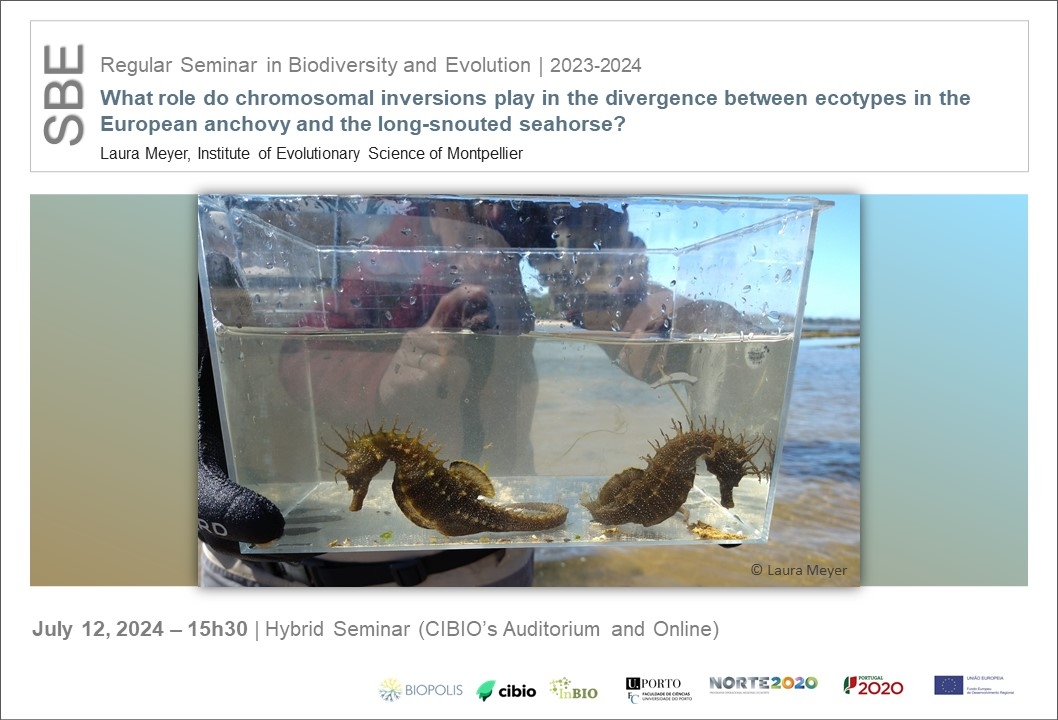What role do chromosomal inversions play in the divergence between ecotypes in the European anchovy and the long-snouted seahorse?
Event
REGULAR SEMINAR IN BIODIVERSITY AND EVOLUTION
July 12th, 2024
Laura Meyer, Institute of Evolutionary Science of Montpellier | 15h30 | Hybrid Seminar

REGULAR SEMINAR IN BIODIVERSITY AND EVOLUTION
Many species show subdivision into phenotypically and genetically differentiated forms that are associated with fine-scale habitat variation. These ecotypes have sometimes been considered to represent an intermediate stage in the formation of new species, and thus offer interesting models for understanding the process of speciation. Ecotypes across many different taxa have been found to be differentiated at chromosomal inversions, which correspond to segments of a chromosome that have been reinserted in the opposite orientation. The role of inversions in contributing to divergence and reproductive isolation is usually ascribed to their ability to protect distinct allelic combinations through recombination suppression. However, many questions remain about how inversion polymorphisms arise, how they are maintained over the long term, and ultimately, whether and how they contribute to speciation.
In this talk I will discuss whether inversions play a role in the divergence between marine and lagoon ecotypes in two species of fish - the European anchovy (Engraulis encrasicolus) and the long-snouted seahorse (Hippocampus guttulatus). Results show that ecotypes in these species are indeed differentiated by multiple large inversions which differ in their patterns and characteristics. I show that the inversions have different evolutionary origins and that their dynamics are expected to be governed by different processes. It seems that some of these inversions are more likely to contribute to speciation than others, but that potential interactions between them could ensure at least moderate reproductive isolation. This has implications for the way we view the role of inversions in speciation, which clearly results from a complex interplay between various factors.
I am a postdoctoral researcher at the Institute of Evolutionary Science of Montpellier (ISEM) working in the field of population genomics and speciation. I have a particular interest in understanding the genomic architecture involved in the buildup of reproductive isolation between diverging populations. I have a broad background in biology, as I started with a BSc in Zoology at my home town university (University of Pretoria, South Africa) and thereafter specialised in marine biology for my Master’s at the University of Bordeaux (France). My PhD in population genomics focused on ecotype speciation in different species of fish, which I completed while working in the marine biodiversity team at ISEM (with Pierre-Alexandre Gagnaire, Bruno Guinand, Nicolas Bierne). This work led me to study the evolutionary dynamics of chromosomal inversions, which are suspected of playing a role in local adaptation and reproductive isolation. My current postdoc aims to investigate the use of new methods based on the Ancestral Recombination Graph for studying the evolution of inversions, a project that is part of the BIOPOLIS collaboration with CIBIO.
[Host: Rui Faria, Seascape Genomics & Speciation - SEAGEN]
